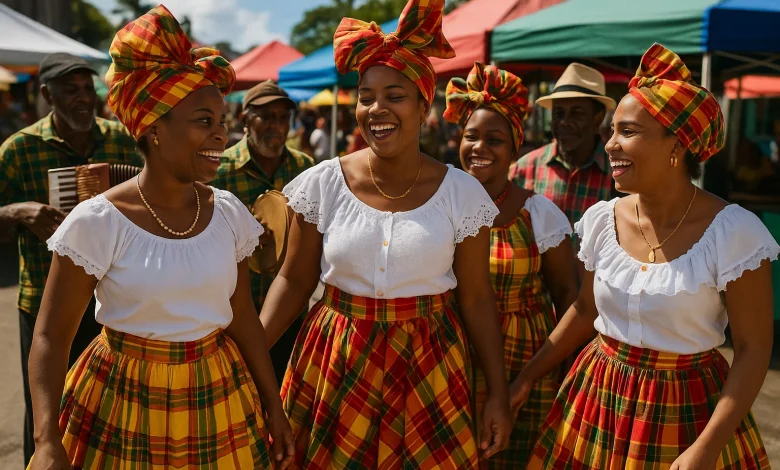Creole Season

Creole Season in Dominica unfolds through October and climaxes with Dominica’s Independence Celebrations on 3 November, filling the island with music, language, fashion, and food that speak to centuries of creativity and resilience. Schools switch to Kwéyòl greetings, offices dress in madras, community centers host workshops, and town squares pulse with performance and food fairs. The calendar features signature events such as Jounen Kwéyòl, Creole in the Park, Jounen Dwapo, Creole Hat Day (Chapeau Paille Day) while markets and cultural venues like Roseau Old Market, Roseau Market, Peebles Park, and the Old Mill Cultural Centre become daily showcases of living heritage. Village councils, youth groups, and cultural organizations coordinate dozens of pop-up activities that bring every parish into the spotlight.
Historical Roots and National Significance
Creole Season is inseparable from national identity. Dominica attained political independence in 1978, and the years that followed saw efforts to celebrate not only constitutional milestones but also the daily culture that defines the island. Early Independence observances emphasized parades and formal speeches; by the early 1980s, cultural leaders began shaping a wider program that explicitly centered Creole traditions. The first official Jounen Kwéyòl arrived in 1983, inspired by regional movements to value Creole language, attire, and folk arts in public life. That pivot helped transform October into Creole Heritage Month, a period when Dominicans choose to express identity through the sounds, flavors, and textures of everyday life.
During the season, language takes a prominent place. Programs devoted to Dominica’s Kwéyòl (Creole) Language encourage schools and offices to speak, read, and perform in Kwéyòl. Storytellers visit classrooms, radio hosts air Creole poems, and community workshops introduce basic conversational phrases to newcomers. The goal is not only celebration but also continuity, so that children grow up with confidence in their linguistic heritage.
Symbols of national pride feature throughout October. Jounen Dwapo focuses attention on the Dominican national flag through school assemblies, community parades, and creative projects that interpret the colors and the Sisserou parrot in textiles and public art. Creole Hat Day invite playful expressions of identity through headwear, from elaborately decorated straw hats to contemporary interpretations that still honor tradition.
Recognition of cultural custodians is another hallmark. The Golden Drum Award honors artists, musicians, researchers, and community organizers who strengthen national culture. Some recipients are mentors to youth groups, others are master drummers or dressmakers, but all help sustain the networks that keep Creole Season vibrant. Their work often spans decades, from village workshops to national stages, and their recognition encourages new generations to take up instruments, crafts, and storytelling.
The season’s history also lives in its spaces. Arawak House of Culture hosts state events as well as community performances, and the Old Mill Cultural Centre in Canefield houses exhibitions and talks that trace craft traditions and music lineages. Historic commercial spaces like the Old Market Square shift from their colonial past to present-day open-air galleries of food, music, textiles, and craftwork. Each site reminds visitors that the story of independence is told not only in speeches but also in the arts of daily life.
Music, Dance, and Cultural Expressions
Sound leads the season. In town squares and village roads, Dominica’s Jing Ping bands tune up the accordion, boom pipe, and Ting Ting (triangle) for dance sets that animate the evening. Elders coach youngsters through steps of traditional and folk dances, building confidence and precision before they step on stage. The Bèlè opens circles where songs call and answer, drums speak to dancers, and communities gather to watch and join. The Contredanse and Quadrille place couples in patterns that carry echoes of European forms reshaped in Caribbean creativity, and school groups perform the Heel and Toe/Polka, and Lancers with evident pride.
Bouyon artists and bands bring contemporary energy to national stages, and names like Asa Bantan are familiar to audiences who gather for Independence concerts. These sets usually come after earlier showcases of jing ping and folk dance, so that a single program can carry audiences from ancestral rhythms to new sounds developed in neighborhood studios. It is common to see elders in traditional dress sitting near teenagers in modern outfits, both moving to the music, both recognizing themselves in the night’s program.
Fashion and pageantry anchor the visual language of the season. Traditional Creole Attire returns to daily life, not as museum exhibit but as living wear. Women step out in the Wob Dwiyet, a gown that flows with bright Madras Cloth and is completed by the Chas (Sash) and a folded headpiece. Workplaces hold dress-up days that become quick fashion shows, while schools host lessons on how to tie headscarves and layer skirts. The Miss Wob Dwiyet pageant crowns ambassadors who demonstrate elegance, knowledge of dress history, and confidence on stage. Men wear madras shirts, sashes, or waistcoats that pair with formal trousers, creating a full palette of Creole color across offices, classrooms, and markets.
October is also the busiest month for cultural institutions. The Old Mill Cultural Centre curates exhibitions on dressmaking, instrument building, and mask-making. Workshops bring together costume designers and student dancers to build performance outfits from scratch. At Peebles Park, schools and community ensembles rehearse in the open air before evening shows, turning the park into a living studio most afternoons. The energy that begins in one town spreads across the island as vehicles carry drums, costumes, and banners to weekend fairs.
Performance work is supported by civic and youth groups. The Karifuna Cultural Group presents Kalinago dance and song, ensuring that indigenous traditions speak within the Creole Season story. Youth organizations such as National Youth Council and Waitukubuli Entrepreneurs Lévé stage open mics, business showcases, and mentorship sessions that help young performers and artisans present their work. Environmental and social groups, including the Dominica Youth Environment Organisation (DYEO), host green markets and river cleanups tied to festival weekends, proving that culture and community service strengthen each other.
Foods, Markets, and Culinary Heritage
Food is the heartbeat that pulls strangers to a table and neighbors into conversation. Creole Season brings out the dishes that Dominicans associate with home, celebration, and village life. Crab Callaloo arrives as a fragrant bowl built from dasheen leaves, coconut milk, local herbs, and crab. Crab Back turns picked crab meat into a savory stuffing returned to the shell, dusted with breadcrumbs and baked to a golden crust. Street vendors pass trays of Codfish Balls, crisp outside and tender inside, usually paired with a pepper sauce that has its own family recipe. Ground provisions like; yams, dasheen, sweet potatoes, cassava, and green bananas, fill plates beside roasted breadfruit and fried plantain, while cocoa tea warms evening events.
Markets function as kitchens, supply chains, and cultural classrooms. At the Roseau Market, shoppers arrive early to secure greens, fish, and herbs. By mid-morning the air carries the aroma of stewed meats and coconut, and by noon families share plates on benches while the next set of musicians prepares. Portsmouth Market usually builds to a Saturday peak when farmers roll in from surrounding communities, while Dawbiney Market Square hosts vendors whose tables layer provisions with condiments, sweets, and craftwork. These markets double as performance spaces: a Jing Ping Ensemble can set up with a few stools and begin a dance circle within minutes.
Restaurants and snack bars craft special menus, often drawing crowds that know the Creole Season calendar by heart. Orchard Restaurant and Pearl’s Cuisine is one example of a venue that leans into heritage plates, serving curated samplers for visitors who want a guided taste of the island. Family-run eateries in villages design weekend menus that feature fish, Agouti, Manicou and smoked meat dishes with provision platters, and many keep coolers of homemade juices using local fruit. Supermarkets such as Fresh Market and H.H.V Whitchurch & Co. Ltd. stock extra herbs, coconut products, and baking supplies through October so that home cooks can prepare feasts for school events and parish fairs.
The food ecosystem depends on farmers, fishers, and cooperatives. In the southeast and east coast, small farms supply markets with dasheen, tannia, and bananas. Fisherfolk from Scotts Head, Soufrière, and Portsmouth add fresh catch to Friday menus. Community organizations help keep the flow steady: the Grand Bay Farmers & Food Producers Cooperative supports aggregation and sales for small producers, and the Castle Bruce Farmer Service Centre gives technical assistance and inputs to growers serving the festival rush. By aligning education, supply, and sales, these groups help market months run smoothly even when weather complicates harvest schedules.
Cooking itself becomes a public art. During Jounen Kwéyòl and the weeks around it, parish groups and school PTAs run food fairs where you might see a line forming for roast breadfruit and saltfish on one side, and a cluster around a booth selling cocoa sticks, cassava breads, or tamarind balls on the other. Creole pastries and cakes appear next to spice displays where elders explain how long they soak fruits for Christmas baking. A visitor can spend a morning walking from stall to stall and come away with a practical education in Dominican home cooking.
Community, Tourism, and Lasting Impact
Behind the lively surface, Creole Season represents careful coordination among agencies, councils, and community leaders. The Dominica Festivals Commission (DFC) manages national schedules, while the Discover Dominica Authority turns the month into a tourism magnet with event information, media campaigns, and support for venues. Hotels bundle accommodation with festival itineraries. Guides offer market walks and attire workshops. Diaspora networks plan trips to coincide with the season so families can gather at shows and parades.
Local governance makes the season feel personal. The Soufriere, Scotts Head, Galion Village Council organizes riverfront pop-ups and musical evenings that reflect the character of the south. The Calibishie Village Council promotes artisan markets and youth recitals that highlight the north coast’s creative energy. The Marigot Village Council coordinates school exhibitions and parish fairs that bring surrounding hamlets into town for a shared day of food and performance. Each council’s calendar gives residents a sense that the national celebration has a local address.
Civic and youth groups use the season to advance community goals. The Dominica Youth Environment Organisation (DYEO) ties green messages to festival stages, offering booths on recycling and watershed health. Charitable organizations run raffles and food stalls that raise funds for school programs and welfare initiatives. Business support agencies like DEXIA and the National Development Foundation of Dominica host micro-marketplaces where start-ups sell spice blends, bush teas, and handmade soaps with Creole branding.
Economic ripples are evident. Vendors experience their strongest weeks of the year. Farmers and fishers gain new buyers who become regular customers after the season. Supermarkets, tailors, hairdressers, and taxi operators see higher sales as families prepare for shows and fairs. Photographers and videographers book back-to-back projects covering pageants, concerts, and parades, creating visual archives that community groups use for future training and promotion.
The season’s influence also extends into the rest of the year. Heritage menus that appear in October often stay in rotation. Dance troupes formed for Independence concerts become permanent ensembles that accept bookings for weddings and hotels. Youth who learn to announce events in Kwéyòl continue as emcees for church fairs and community fundraisers. Agencies leverage October’s momentum to promote heritage tourism and indigenous tourism, encouraging visitors to return for smaller festivals or village feasts in other months.
Creole Season endures because it belongs to everyone who contributes. Dressmakers, drummers, schoolchildren, farmers, fishers, parish organizers, restaurant staff, radio hosts, and returning diaspora all find a place in the program. The season reminds Dominicans that the arts of daily life can fill public spaces with joy and purpose. When November 3rd arrives, the parades and concerts feel like a natural crest to a month of rehearsals, cooking, learning, and celebration. The next morning the island exhales, kitchens convert leftovers into family meals, and instruments are set aside for a rest. Yet the lessons learned in October carry forward, ready to be put to work at the next village celebration, market day, or school show. That continuity explains why Creole Season stands as a reference point for identity, education, and livelihoods, rooted in the everyday experiences of Dominican people.




